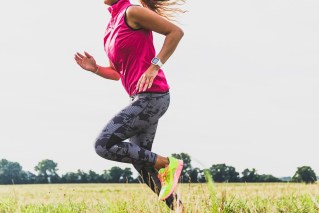What causes a stitch? How to avoid and treat the frustrating problem

An inconvenient stitch can stop even the most experienced runner in their tracks. Photo: Getty
Whether you’re a recreational runner or a competitive athlete, getting a stitch can stop you in your tracks.
A stitch is a pain in the abdomen (usually on the side) that’s brought on by activity. It can range from sharp or stabbing to mild cramping, aching or pulling, and may involve pain in the shoulder tip too. Often it leaves you with no choice but to slow down or stop.
Despite being very common, the exact cause of a stitch isn’t fully understood, says Australian scientist Dr Darren Morton, who did his PhD on stitches and has been involved in numerous studies since.
Early theories suggested stitches were caused by a lack of oxygen to the diaphragm, or by the jiggling of ligaments connecting abdominal organs to it.
But those theories have gone out of favour because evidence doesn’t support them, says Dr Morton, a senior lecturer in the Faculty of Education and Science at Avondale College of Higher Education in NSW.
Dr Morton used to suffer badly from stitches himself in his earlier athletic career as an ironman, triathlete and surf lifesaver. This first-hand suffering turned into something of a scientific obsession with stitches.
He was the author of eight of the 14 key studies he reviewed in a recent article on Exercise Related Transient Abdominal Pain (ETAP, the medical name for stitches) in the journal Sports Medicine.
He says he’s now “99 per cent sure” that what’s really behind a stitch is an irritation of the membrane lining the abdominal cavity. He also strongly suspects that what (and when) you eat and drink before you get active can raise or lower the odds of you getting a stitch.
“We’ve got no evidence of anyone dying from stitches, so in that regard, they’re relatively benign,” Dr Morton says.
“But over the years I’ve had hundreds of emails from people saying ‘please help me, I’ve got some big event coming up’. And I know plenty of people who say ‘I don’t want to go for a run because I always get a stitch’.”
Tips to avoid a stitch
Dr Morton has some tips to reduce the odds of a stitch next time you get active.
There’s most evidence for these:
- Make sure you’re well hydrated by drinking lots of water in the 12 hours before you exercise.
- In the two hours immediately before, drink only small amounts so you stay hydrated, but your stomach’s not bloated (and therefore less likely to press on the lining of your abdominal cavity).
- Don’t eat large volumes of food for at least two hours before exercise (perhaps even three to four hours before if you’re especially prone to stitches).
- Avoid very sugary drinks, such as fruit juice or soft drinks, before or during your exercise. Sugary foods like lollies may also be a problem. There’s less evidence for these, but they’re still worth a try:
- Get fitter: Some evidence suggests the fitter you are, the less frequently you get stitches. Exactly why isn’t understood. But plenty of very fit athletes are still plagued by them.
- Strengthen your core: Strong trunk muscles, especially the deeper abdominal muscles, the transverse abdominus, may help ward stitches off, probably by offering more support to abdominal organs. Pilates and exercises using a stability ball may help.
- Improve your posture: “We haven’t yet done intervention studies to see if changing people’s posture makes a difference but we have anecdotal reports of people who’ve done that and it’s been helpful.” A physiotherapist may be able to help.
If you do get a stitch, you might find the following techniques can bring relief:
- Deep breathing
- Pushing or stretching the affected area
- Bending over forward.
In lab experiments, stitches generally disappeared 45 seconds to two minutes after stopping activity. Some people can still feel sore a couple of days later though.
A fraction too much friction
So how does irritation in the lining of your abdomen lead to a stitch?
The lining, known as the parietal peritoneum, has two layers.The outer layer lies tight against the front abdominal wall and folds around under the diaphragm (the muscle sheet separating your chest from your abdomen).The inner layer wraps around the contours of the abdominal organs.
Between the two layers is a small amount of fluid, which helps reduce friction when your organs shift as your body moves.The theory is that a stitch happens when this protective system goes wrong and there is friction between the layers.
Since the lining is attached to a nerve called the phrenic nerve, which refers pain to the shoulder tip region, this may explain why some people get shoulder tip pain with a stitch.
Sugary drink link
It’s thought one factor that can lead to friction between the layers is pressure from the inside the body when organs, such as your stomach, are very full and swollen.
But it can also happen when the amount of fluid in the space between the two layers drops. This can happen after drinking concentrated fluids such as sugary drinks, Dr Morton says.
“What we know is that things like really sugary drinks draw fluid out of that space and are very provocative of stitches.”
In experiments where people are given such drinks, like fruit juice or soft drink, and then asked to exercise “everyone sort of keels over left, right and centre with a stitch”, he explains.
Sports drinks, which are about 6 per cent sugar (compared to about 11 per cent for fruit juice), don’t have this effect. In fact, they are no worse than water at bringing on a stitch.
Sugary drinks also reduce the rate at which the stomach empties its contents into the intestines, which may have a “double whammy” effect, leading to bloating and further friction through direct pressure.
While high fat foods also slow the emptying of the stomach, and hence help to bring on stitches, they’re less frequently eaten before exercise than high sugar food and drinks.
The stitches that plagued Dr Morton in his youth are no longer an issue.
This fits with the general finding that people tend to grow out of stitches “probably because the nature of our tissues changes as we age”, he says.
“I very seldom get stitches now and I used to get really debilitated by them. I used to get them just walking around. It probably just indicates I’m growing old… or I’m not running fast enough.”
– ABC








